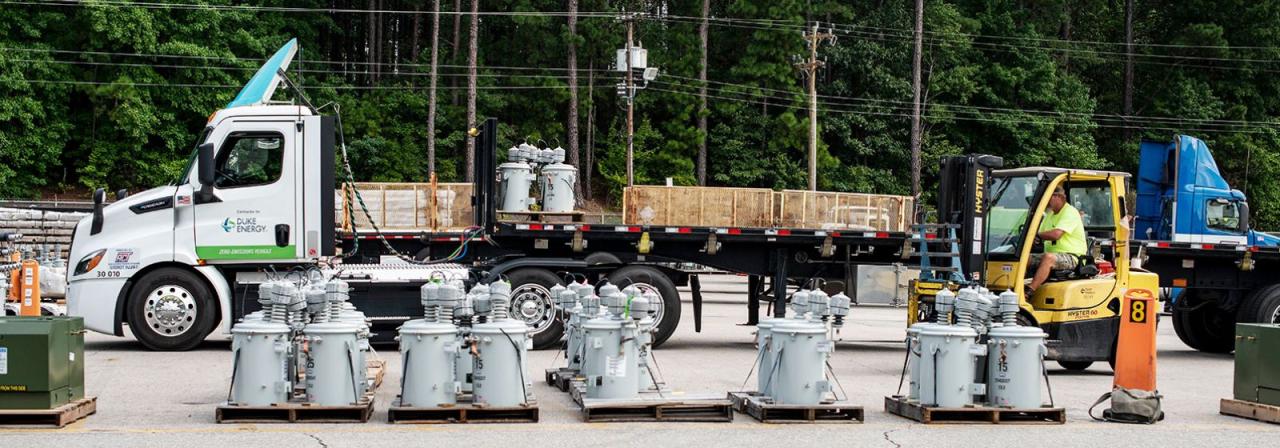Duke Energy Electrifies Its First Supply Chain Logistics Route
Duke Energy has launched a pioneering pilot project in North Carolina, testing an electric semitruck for supply chain logistics. The initiative, started in 2024, focuses on electrifying a vehicle that helps transport $1.5 billion worth of cargo annually. The EV semitruck covers approximately 500 miles weekly for the Garner Distribution Center, serving the Raleigh area. Initial results show significant benefits: from January to mid-August, the EV tractor drove 14,000 miles, saving nearly 1,947 gallons of diesel fuel and approximately $7,500 in fuel costs, while reducing CO2 emissions by 19.6 metric tons. The project demonstrates the viability of electric vehicles for commercial transportation within the 250-mile range limit.
Duke Energy ha avviato un progetto pilota pionieristico nella Carolina del Nord, testando un camion elettrico per la logistica della catena di approvvigionamento. L'iniziativa, iniziata nel 2024, si concentra sull'elettrificazione di un veicolo che aiuta a trasportare merci per un valore di 1,5 miliardi di dollari all'anno. Il camion elettrico percorre circa 500 miglia a settimana per il Centro di Distribuzione di Garner, servendo l'area di Raleigh. I risultati iniziali mostrano benefici significativi: da gennaio a metà agosto, il trattore elettrico ha percorso 14.000 miglia, risparmiando quasi 1.947 galloni di carburante diesele e circa 7.500 dollari in costi di carburante, riducendo le emissioni di CO2 di 19,6 tonnellate metriche. Il progetto dimostra la fattibilità dei veicoli elettrici per il trasporto commerciale entro il limite di 250 miglia.
Duke Energy ha lanzado un proyecto piloto pionero en Carolina del Norte, probando un camión semieléctrico para la logística de la cadena de suministro. La iniciativa, comenzada en 2024, se centra en electrificar un vehículo que ayuda a transportar mercancías por un valor de 1.5 mil millones de dólares anuales. El camión eléctrico recorre aproximadamente 500 millas por semana para el Centro de Distribución de Garner, sirviendo al área de Raleigh. Los resultados iniciales muestran beneficios significativos: desde enero hasta mediados de agosto, el tractor eléctrico recorrió 14,000 millas, ahorrando casi 1,947 galones de combustible diésel y aproximadamente 7,500 dólares en costos de combustible, reduciendo las emisiones de CO2 en 19.6 toneladas métricas. El proyecto demuestra la viabilidad de los vehículos eléctricos para el transporte comercial dentro del límite de 250 millas.
듀크 에너지는 노스캐롤라이나에서 공급망 물류를 위한 전기 세미트럭을 시험하는 혁신적인 시범 프로젝트를 시작했습니다. 2024년에 시작된 이 이니셔티브는 연간 15억 달러 가치의 화물을 운송하는 차량의 전기화에 중점을 두고 있습니다. 이 전기 세미트럭은 갈너 배급 센터를 위해 주당 약 500마일을 주행하며, 롤리 지역에 서비스를 제공합니다. 초기 결과는 상당한 혜택을 보여줍니다: 1월부터 8월 중순까지 전기 트랙터는 14,000마일을 주행했으며, 거의 1,947갤런의 디젤 연료를 절약하고 약 7,500달러의 연료 비용을 아끼며 이산화탄소 배출량을 19.6미터톤 줄였습니다. 이 프로젝트는 250마일 범위 내에서 상업 운송을 위한 전기 차량의 실행 가능성을 보여줍니다.
Duke Energy a lancé un projet pilote innovant en Caroline du Nord, testant un camion semi-remorque électrique pour la logistique de la chaîne d'approvisionnement. L'initiative, commencée en 2024, se concentre sur l'électrification d'un véhicule qui aide à transporter des marchandises d'une valeur de 1,5 milliard de dollars par an. Le camion électrique parcourt environ 500 miles par semaine pour le Centre de Distribution de Garner, au service de la région de Raleigh. Les résultats préliminaires montrent des avantages significatifs : de janvier à la mi-août, le tracteur électrique a parcouru 14 000 miles, économisant près de 1 947 gallons de diesel et environ 7 500 dollars en coûts de carburant, tout en réduisant les émissions de CO2 de 19,6 tonnes métriques. Le projet démontre la viabilité des véhicules électriques pour le transport commercial dans la limite de 250 miles.
Duke Energy hat ein wegweisendes Pilotprojekt in North Carolina gestartet, bei dem ein elektrischer Sattelzug für die Logistik der Lieferkette getestet wird. Die Initiative, die 2024 begann, konzentriert sich darauf, ein Fahrzeug zu elektrifizieren, das jährlich Waren im Wert von 1,5 Milliarden Dollar transportiert. Der Elektro-Sattelzug fährt wöchentlich etwa 500 Meilen für das Garner-Verteilzentrum und bedient die Region Raleigh. Erste Ergebnisse zeigen erhebliche Vorteile: Von Januar bis Mitte August legte der Elektro-Traktor 14.000 Meilen zurück, sparte nahezu 1.947 Gallonen Diesel und etwa 7.500 Dollar an Kraftstoffkosten und reduzierte die CO2-Emissionen um 19,6 metrische Tonnen. Das Projekt zeigt die Machbarkeit von Elektrofahrzeugen für den kommerziellen Transport innerhalb des 250-Meilen-Radius.
- Achieved $7,500 in fuel cost savings during pilot period
- Reduced CO2 emissions by 19.6 metric tons
- Demonstrated operational viability with 14,000 miles covered
- Lower maintenance costs due to fewer mechanical repairs needed
- Successfully electrified route handling $1.5B worth of annual cargo
- 250-mile range constraint for EV semitruck operations
- Requires 2-hour charging time between routes
Insights
The electrification of Duke Energy's supply chain logistics represents a significant pilot project with measurable environmental and operational benefits. The initiative has demonstrated compelling results:
The pilot's success in maintaining operational efficiency while reducing emissions aligns with Duke Energy's 2050 net-zero carbon goals. The demonstrated ability to quick-charge in two hours and maintain delivery schedules addresses key concerns about EV reliability in commercial applications. This operational validation could accelerate the adoption of electric vehicles in commercial fleets, particularly for predictable routes within the vehicle's range capabilities.
This pilot program has strategic implications beyond immediate environmental benefits. Duke Energy is positioning itself ahead of projected energy consumption growth, with EVs expected to drive
The initiative demonstrates Duke Energy's dual role as both an EV adopter and infrastructure enabler. By experiencing firsthand the challenges and opportunities of fleet electrification, the company is better positioned to support commercial customers' transition to EVs. This practical experience strengthens Duke Energy's credibility in the EV space and could lead to new revenue streams from fleet electrification consulting and charging infrastructure services.
North Carolina pilot project seeks to determine if electrification is a viable option for commercial vehicles used for essential work
NORTHAMPTON, MA / ACCESSWIRE / November 21, 2024 / Duke Energy

By Liz Rothaus Bertrand | illumination Contributor
Duke Energy is road testing an electric semitruck in North Carolina - a first-of-its-kind pilot project at the company that is reducing air pollution from transportation, the largest domestic contributorof greenhouse gases.
By replacing a traditional semitruck with a zero-emissions vehicle, Duke Energy found it can electrify a supply chain logistics route, efficiently moving materials to its operations centers without burning gasoline or diesel.
Launched in 2024, the pilot focused on electrifying one of the commercial vehicles that transport
Duke Energy's Supply Chain Management team worked with contractor AAA Cooper to procure an EV semitruck for distribution routes covering about 500 miles weekly for the Garner Distribution Center, which serves several sites in the Raleigh, N.C., area.
"We move materials to the right place, at the right time, and in the right quantity," said Logistics Manager Brad Withers. "Think of our role as the link between each node, transporting materials so that our teams can maintain, repair and build new infrastructure efficiently."
Meighan Read, manager of products and services at Duke Energy, said the team identified routes within the vehicle's 250-mile range (on a full charge) to ensure equipment and supplies were delivered on time.
"EVs can be a challenge," Read said, "but with the right application - whether it's an electric vehicle or another alternative fuel - they can meet operational needs. That's one of the biggest learnings from this pilot project: Electric can work in the right application."
Also promising, Withers said, is the speed at which the zero-emissions truck could be charged and redeployed to continue delivering materials.
"We've learned that an EV semitruck can haul and perform like a diesel truck. If necessary, the vehicle can come back, get a healthy charge in about two hours, and deliver the remaining materials to be on time to those locations."
This flexibility is vital as Duke Energy invests in major electric grid upgrades and cleaner energy sources, including expanded storage, renewables, natural gas and nuclear.
"I'm incredibly proud of my team for advocating for new ideas like this," said Dwight Jacobs, senior vice president, supply chain, real estate and chief procurement officer. "We're not just leading one of the largest clean energy transitions in North America - we're literally driving it forward."
Between January and mid-August, the pilot project's EV tractor drove 14,000 miles, saving nearly 1,947 gallons of diesel fuel and approximately
Electric vehicles also require less maintenancethan conventional vehicles. Without a diesel engine, an EV tractor doesn't need oil changes or as many mechanical repairs.
As the company works toward net-zero carbon emissions by 2050, Duke Energy is exploring other ways to cut carbon, some of which have already been implemented - like the Electric Power Take Off (ePTO) systems for material handling bucket trucks. The ePTO system uses a traditional chassis but operates the truck's boom and auxiliary functions entirely off a battery once on-site, saving fuel and reducing greenhouse gas emissions.
"It also has safety benefits by making job sites quieter," Read added. "People in the bucket can talk to folks on the ground and hear them more clearly."
It's one more example, she said, of finding the right technology to match the application.
These pilot projects, including the one that electrified Duke Energy's first supply chain route, continue to provide valuable data. "These projects demonstrate our commitment to cleaner energy," Withers said. "Electrification is new for larger commercial vehicles at the company, but it's a step we're evaluating as part of our long-term strategy."
We're working to increase access to EV charging, research how it affects the grid and help electrify fleets
Over the next 26 years, energy consumption is predicted to grow at an average annual rate of nearly
Duke Energy has been preparing for this transition - monitoring and implementing EV load management, and managing charging programs and pilots to help customers save money while lessening the impacts of EVs to system peaks.
You can help play a part, too. If your business is considering adding EVs to its fleet, reach out to Duke Energy so we can help assure a smooth transition. Residential customers can also benefit from Duke Energy EV rebate programs and other resources.
View original content here.
View additional multimedia and more ESG storytelling from Duke Energy on 3blmedia.com.
Contact Info:
Spokesperson: Duke Energy
Website: https://www.3blmedia.com/profiles/duke-energy
Email: info@3blmedia.com
SOURCE: Duke Energy
View the original press release on accesswire.com







